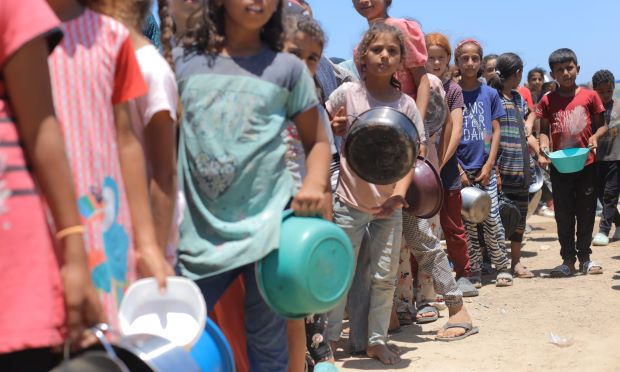Hepatitis A and other diseases surge among Gaza’s displaced, says UN
By Adam Sella and Matthew Mpoke Bigg
GAZA STRIP – Sally Thabet, 40, said she had done all she could to protect her three daughters from illness after they fled their home in Gaza City, taking refuge in the town of Deir al Balah. But living in a former minimart, sharing a toilet with 20 others and washing dishes with dirty seawater, no amount of hand sanitizer could help.
One by one her girls fell sick with what doctors diagnosed as hepatitis A, a viral liver infection that is transmitted through person-to-person contact or contaminated food or water, and can spread quickly in unsanitary conditions.
“Amoon was the first to be diagnosed two months ago,” she said last week, adding that the 10-year-old girl developed a stomach ache, stopped eating, started vomiting and looked pale. “I couldn’t see how yellowish she was because it is very dark inside the store.” Her other two children, Kenzy 15, and Kandi, 11, followed soon after.
More than 100,000 people in the Gaza Strip have contracted acute jaundice syndrome, or suspected hepatitis A, since the Israeli war on Hamas began on Oct. 7, the World Health Organization (WHO) said last week.
It is just one disease that has spread rapidly in Gaza as most of the territory’s 2.2 million people have fled their homes, forced to live in squalid, crowded camps and makeshift shelters, while basic needs like clean water, sewage treatment, trash collection, soap and fuel for cooking have grown scarce.
There are also nearly 1 million cases of acute respiratory infections, half a million cases of diarrhoea and 100,000 cases of lice and scabies, the WHO said. On Friday (19), the agency’s chief, Dr. Tedros Adhanom Ghebreyesus, said that even polio, a disease that has been eradicated in much of the world, was present in Gaza. A variant of poliovirus has turned up there in six samples of water or wastewater, he said, meaning that some people there are infected, though no symptomatic cases have been reported.
Dr. Hanan Balkhy, the WHO director for the eastern Mediterranean region, told members of the media: “In the Gaza Strip, where garbage and sewage fill the streets, cases of acute respiratory infections, diarrheal illnesses, acute jaundice syndrome and skin infections are surging. The situation is indeed dire.”
People with hepatitis A usually recover fully within weeks or a few months, but some become seriously ill and a small number die. (It is unrelated to the more serious and long-lasting hepatitis B and C, which spread through blood contact.)
In the developed world, diarrhoeal illnesses and diseases such as hepatitis A are relatively rare, and often not very serious. But in chaotic and crowded places with poor sanitation and malnutrition, they become much more common and dangerous. Since the war began, aid workers have warned of the threat of more serious epidemics in Gaza like cholera, which can quickly lead to mass mortality, but so far those have not materialized.
The disease spread in Gaza has coincided with Israeli airstrikes and ground combat in and around hospitals and clinics, damaging nearly all of them and forcing many to close. The large number of people treated for war injuries — almost 90,000, Gaza’s health ministry says — and the surge in illness have overwhelmed Gaza’s diminished medical system.
Balkhy said that more than 1,000 attacks on health care have been reported since Oct. 7. Israel’s military says that Hamas has stationed fighters and military equipment in hospitals as well as beneath them to take advantage of the cover they provide, a charge that Hamas and hospital officials dispute.
The Israeli military has launched two operations at Gaza’s largest hospital, Shifa, fighting deadly battles with militants there. An investigation by The New York Times found evidence that Hamas had stored weapons in tunnels beneath the hospital but could not confirm the Israeli claim that it was a Hamas command and control centre.
Before the war, Gaza’s health care system was “reasonably well functional,” said Dr. Rik Peeperkorn, the WHO’s representative to Gaza and the West Bank. Now, fewer than half of its facilities remain even partly operational, he said, and its healthcare workforce is severely depleted.
Israel has promoted the establishment of new field hospitals to expand medical infrastructure for civilians in Gaza, according to COGAT, the arm of the Israeli military that implements policy in the occupied West Bank and Gaza.
-New York Times



Comments are closed, but trackbacks and pingbacks are open.